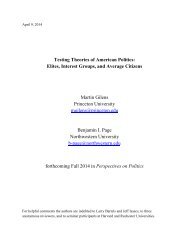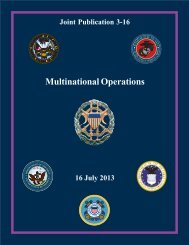ABUSE OF STRUCTURED FINANCIAL PRODUCTS- Misusing Basket Options to Avoid Taxes and Leverage Limits MAJORITY AND MINORITY STAFF REPORT
ABUSE OF STRUCTURED FINANCIAL PRODUCTS- Misusing Basket Options to Avoid Taxes and Leverage Limits MAJORITY AND MINORITY STAFF REPORT
ABUSE OF STRUCTURED FINANCIAL PRODUCTS- Misusing Basket Options to Avoid Taxes and Leverage Limits MAJORITY AND MINORITY STAFF REPORT
You also want an ePaper? Increase the reach of your titles
YUMPU automatically turns print PDFs into web optimized ePapers that Google loves.
92<br />
system, the many ways in which financial firms are bypassing federal margin rules <strong>and</strong> leverage<br />
limits, <strong>and</strong> the extent <strong>to</strong> which highly leveraged financial instruments <strong>and</strong> arrangements may be<br />
contributing <strong>to</strong> overextensions of credit by lenders, asset bubbles, <strong>and</strong> systemic risks. Federal<br />
margin rules, which are a direct response <strong>to</strong> the s<strong>to</strong>ck market crash of 1929, represent a vital<br />
financial safeguard whose circumvention is <strong>to</strong>o important <strong>to</strong> be disregarded by federal regula<strong>to</strong>rs<br />
charged with detecting <strong>and</strong> evaluating systemic risk.<br />
More generally, the financial sec<strong>to</strong>r <strong>and</strong> the corporate community are using derivatives <strong>to</strong><br />
try <strong>to</strong> achieve a variety of favorable outcomes in accounting, tax, financial, <strong>and</strong> other regula<strong>to</strong>ry<br />
contexts, even when the derivative instruments mimic economic activities that by themselves<br />
yield different results. Two examples have been highlighted in this report. Congress <strong>and</strong> the<br />
appropriate agencies should closely examine the growing use of derivatives <strong>to</strong> circumvent<br />
accounting, tax, or regula<strong>to</strong>ry rules, <strong>and</strong> what steps should be taken <strong>to</strong> prevent disparate<br />
outcomes, particularly when they may pose a threat <strong>to</strong> the transparency, safety, soundness of our<br />
financial system or the economy as a whole.<br />
Auditing Large Partnerships. Third, despite ongoing IRS audits of RenTec’s basket<br />
options activities, the IRS’ overall audit coverage of large partnerships similar <strong>to</strong> RenTec is poor.<br />
Large partnerships – which include hedge funds, private equity funds, <strong>and</strong> publicly traded<br />
partnerships – are some of the most profitable entities in the United States. According <strong>to</strong> a 2013<br />
preliminary report issued by the U.S. Government Accountability Office (GAO), “[i]n tax year<br />
2011, nearly 3.3 million partnerships accounted for $20.6 trillion in assets <strong>and</strong> $580.9 billion in<br />
<strong>to</strong>tal net income.” 497<br />
That GAO report also found that the IRS was failing <strong>to</strong> audit 99% of the tax returns filed<br />
by large partnerships with assets exceeding $100 million. 498 The GAO report showed that while<br />
the number of those large partnerships had increased significantly in recent years, IRS audits had<br />
not kept pace. According <strong>to</strong> the GAO after examining a ten-year time frame, between tax years<br />
2002 <strong>and</strong> 2011, the number of businesses organized as “large partnerships (with 100 or more<br />
direct partners <strong>and</strong> $100 million or more in assets) increased more than 200 percent, accounting<br />
for $2.3 trillion in <strong>to</strong>tal assets <strong>and</strong> $69.1 billion in <strong>to</strong>tal net income by tax year 2011.” 499 The<br />
IRS’ audit efforts worsened yet again in 2012. According <strong>to</strong> the preliminary report, IRS field<br />
audits reviewed the books <strong>and</strong> records of only 0.8% of large partnership returns. 500<br />
In response <strong>to</strong> a Subcommittee inquiry about low audit coverage of large partnerships, the<br />
IRS Large Business <strong>and</strong> International Division <strong>and</strong> Office of Chief Counsel explained that one of<br />
the reasons for the low audit performance was because of the procedural hurdles erected by the<br />
Tax Equity <strong>and</strong> Fiscal Responsibility Act (TEFRA). 501 The IRS pointed out that a TEFRA<br />
notification provision requires the IRS <strong>to</strong> notify all partners holding more than a 1% interest in a<br />
partnership prior <strong>to</strong> initiating an audit. 502 The IRS explained that some large partnerships, such<br />
497 3/19/2014 “Large Partnerships: Characteristics of Population <strong>and</strong> IRS Audits,” prepared by the Government<br />
Accountability Office, GAO-14-379R, at 1, http://www.gao.gov/assets/670/661772.pdf.<br />
498 Id. at 4, 6.<br />
499 Id. at 1.<br />
500 Id. at 20.<br />
501 Tax Equity <strong>and</strong> Fiscal Responsibility Act of 1982, Pub. L. No. 97-248.<br />
502 26 U.S.C. § 6223.







